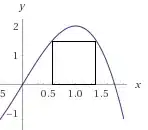A square having sides parallel to the coordinate axes is inscribed in the region.
{$(x,y):x,y>0:y\le -x^3+3x$}.
If the area of the square is written as $A^{1/3}+B^{1/3}$ square units where $A,B\in \Bbb Z$ and $A>B$, then find
(i)$\sqrt{A-B}$
(ii)Slope of line with x and y intercepts as $A,B$ respectively
(iii)$A+B\over A-B$
(iv)Circumradius of $\triangle OPQ$ where $O$ is origin, $P(A^{1/3},0)$ and $Q(0,B^{1/3})$
My approach:
Let the square be $KLMN$ where $K,L$ lie on x-axis with coordinates $(a,0);(b,0)$ respectively.
This will give coordinates of other points i.e. $M,N$ in terms of $a,b$.
Now taking out the length of all sides and equating them will give $a,b$.
Problem with my approach:
I end up in a cumbersome equation involving $a,b$
Tips: I know nothing more than simple differentiation and limits. So please avoid solutions with integration and other stuffs.
PS: No need to downvote as I'm on the verge of getting banned. Please comment if you have any problem with the question.

